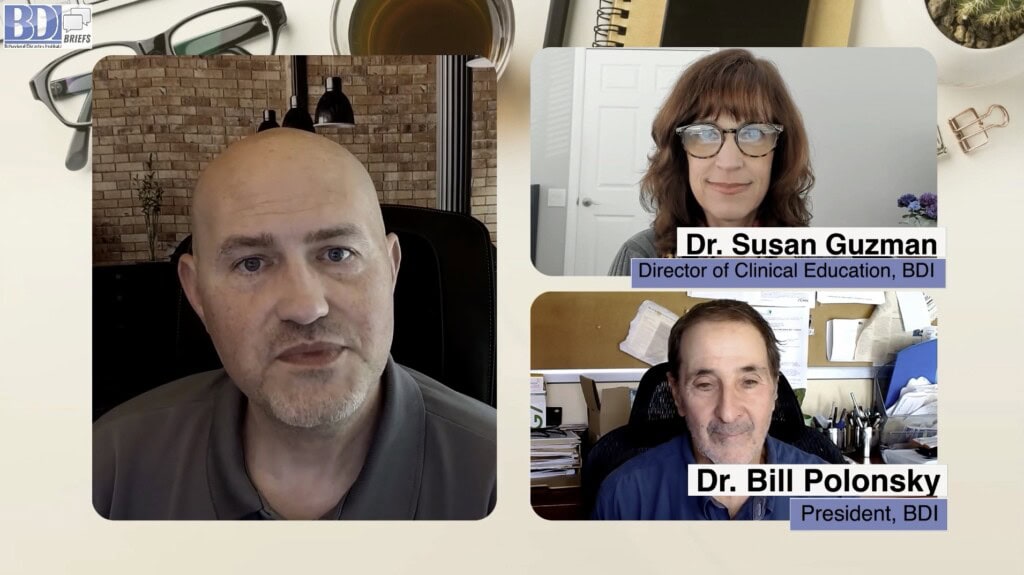[00:08:57] Dr. Bill Polonsky: So again, just to be repetitive. You can still use the PAID just like it’s been used all this time. You can still use the DDS, the Diabetes Distress Scale. What we think is a better choice is this 8 item core scale. The core scale that was developed for the T1-DDAS and the T2-DDAS. One of the things we like about it so much, it’s really short.
[00:09:22] Dr. Bill Polonsky: Eight items. That’s it. now you could use more, but if it’s a mixed sample, just those eight items, and that’s what we see more and more busy researchers are doing. They simply don’t want to overwhelm people with too many items. And that eight item core scale is very valuable. And by the way, we know that some of you have used something, I hate to say this, something else we developed years ago, which was a two item screener, a diabetes distress screener.
[00:09:50] Dr. Bill Polonsky: And if I remember correctly, these were items that came from the DDS, the Diabetes Distress Scale and we have seen that two item screener being used in studies and in practices all over the place. We just don’t think it’s a very good idea. People are using those, that two item scale, hard for me to call it a scale, and thinking that’s measuring diabetes distress.
[00:10:14] Dr. Bill Polonsky: But it’s really, it’s just a screener. So if you want to keep things really short because you’re doing a research study or you’re worried about overwhelming your patients, just use that core scale – the last thing on this slide that you have right in front of you.. Susan, I think you support that idea a lot.
[00:10:32] Dr. Bill Polonsky: Any thoughts about that?
[00:10:35] Dr. Susan Guzman: Yeah, I think that we’re gonna miss a lot of folks if you’re only using the two items. as a way to indicate whether a person has distress or not. and really we would like to argue that, use the whole subscale. We know that’s not realistic in a lot of settings or, perhaps in research, but we know that, people may have one source scale that’s elevated and that’s worthy of a conversation.
[00:11:04] Dr. Susan Guzman: And if you think about not thinking of measuring distress as like a, as a, indicating a pathology or a mental health disorder, but rather somebody’s saying, in regards to the emotional side of diabetes, I’m having challenges. And these challenges are worthy of a conversation. And so in terms of a clinical conversation, we think that we’d like people to be assessed in a more comprehensive way.
[00:11:31] Dr. Bill Polonsky: Yeah that’s perfect. Now to be fair, if you think about that first slide I showed you, where we had these all seven scales, and I said we’re going to focus on these first five. There’s other good reasons why people are still going to go back and use the PAID or the DDS or the T1 DDS and it comes, it has to do with other things.
[00:11:51] Dr. Bill Polonsky: Maybe you want to use this scale in a study that’s in a different language. for these, our new scales, the T1 and T2 DDAS, they’re new. We don’t have them in a lot of other languages. Spanish, maybe one more. But the DDS, for example, which has now been used for 20 years, is available in almost 40 languages.
[00:12:12] Dr. Bill Polonsky: And all of these you can find on our website at behavioraldiabetes. org. And they’re, all of this, except for the PAID I should say, all of these are freely available to people with diabetes, to researchers, to use anywhere, any way they want. So feel free to check it out on our website, behavioraldiabetes.org.
[00:12:33] Dr. Bill Polonsky: We don’t have the PAID on our website. We don’t, that’s the one, instrument that we don’t hold the copyright to. If you’re interested in doing research with the PAID you should contact the copyright holder, which is my old employer, the Joslin Diabetes Center in Boston. Now, the other thing I want to mention, a thing that I think we’re really proud of, if you’re interested in not going to our website and downloading these instruments and taking a look at them, but wanting to try them, now, there’s this other really interesting thing you should know about that I think we talked about briefly before, and I’m going to show you one more slide so you can see what that page looks like.
[00:13:11] Dr. Bill Polonsky: And it’s called, DiabetesDistress.org. And what we’re so proud about DiabetesDistress. org, is of those first five scales, except for the PAID all other four are freely available for you to check out and use and get feedback for right here, right now. You can go to this scale, you can go to this website, you can complete the scale just by touching the right, whatever numbers make sense to you as you fill it out, feel free to check it out any time you want, and it’s automatically scored, and it gives you a little summary page so you can see how you scored in terms of, the total score, what the sub scales are, the source scales, the core scale, whatever, whichever instruments you might pick. We have them all in English and Spanish on this website.


